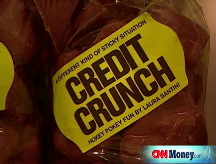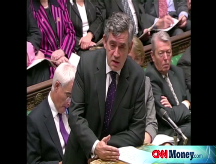Credit squeeze: Small signs of easing
3-month interbank lending rate retreats modestly, but still at high levels as unease over the crisis prevails.
NEW YORK (CNNMoney.com) -- Lenders remained reluctant to lend Monday, even as a key interbank interest rate eased ever-so-slightly in a tentative first step in the right direction for the choked credit markets.
Investors were also waiting to see whether the most recent global efforts would increase liquidity and jump start world economies.
Several countries on Monday unveiled plans to guarantee bank loans and inject capital into struggling banks. And the Federal Reserve said it would offer unlimited dollars on a short-term basis (one week, 28 days, 84 days) at a fixed interest rate to the Bank of England, European Central Bank and Swiss National Bank.
"These announcements should help restore confidence and we should see more normality return to the credit markets over the next several weeks," said Peter Cardillo, chief market strategist at Avalon Partners.
However, as with all moves of this magnitude, it will take time to work through the system before credit markets show some semblance of normalcy.
"This is a meaningful step in the right direction," said Cardillo, but "it is going to take a while."
U.S. bond markets were closed in observance of Columbus Day.
Signs of easing?: The 3-month Libor edged lower to 4.75%, according to the British Bankers Association, signaling the first cracks in the frozen credit market. The rate had reached 4.82% on Friday - the highest since mid-December 2007, according to data from Bloomberg.com.
The decrease in the 3-month Libor rate from 4.82% Friday to 4.75% Monday tied the largest drop in the 3-month lending rate since March 17, when the measure fell 0.18 percentage points, from 2.76% to 2.58%. On May 1, the measure also fell 0.07%.
Despite the easing, rates remain at elevated levels. Just a month ago, the 3-month rate was 2.82%.
Libor is a daily average of what 16 different banks charge other banks to lend money in London and affects the price of a wide range of loans, including for adjustable-rate mortgages, and student and auto loans.
The dip was seen as the start of the thaw for frozen credit lines but only just the start.
"It is a positive, but it is just a beginning," said Steve Van Order, chief fixed income strategist at Calvert Funds. "The next thing is we need the rates start to come down more generally from these lofty levels," he added.
Another market gauge, the Libor-OIS spread, also eased as much as 0.12% to a low of 3.55% Monday, before ticking back up slightly to 3.59%.
The Libor-OIS spread measures how much cash is available for lending between banks, and is used by banks to determine lending rates. It calculates the difference between the 3-month Libor and the Overnight Index Swaps. The bigger the spread, the less cash is available for lending.
The overnight Libor rate was not published because U.S. bond trading was closed for Columbus Day, said the BBA.
The overnight lending rate had dropped to 2.47% Friday, sharply lower than the previous two session. Part of the decline signaled lender willingness for very short-term loans, while part was attributed to the recent government interventions worldwide aimed at shoring up troubled banks. The overnight Libor had spiked as high as 6.88% after the U.S. $700 billion bailout bill was signed into law.
A rally on Wall Street was also boosting sentiment. "Last week there was no confidence. This week we are starting off with confidence [and] maintaining that confidence is going to be key," said Van Order. The Dow industrials surged over 600 points - a nice respite after plummeting nearly 2,400 points over the past eight sessions.
Lifeline to the banks: Monday morning, the British Treasury announced it will pump $63 billion into the Royal Bank of Scotland, HBOS and Lloyds TSB, three of the country's largest banks, to help them regain footing.
Additionally, Neel Kashkari, interim assistant secretary for financial stability who is in charge of the $700 billion bailout program spoke Monday before U.S. markets opened. He outlined the government's multi-prong effort but offered up few details. The U.S. government is also working on a plan to buy stock in financial institutions.
Van Order said that one of the key elements for restoring confidence to the credit markets was the government's backing of financial institutions. "The pledge by the government that we are not going to have another Lehman Brothers" was critically important for banks to begin to lend again, as oppose to sit on their cash, he said.
Banks are not interested in lending to other banks, let alone consumers, when there is no confidence that the institution will live to return the amount of the loan, explained Van Order.
Global moves: President Bush and finance officials from the United States and the Group of Seven Finance Ministers, Group of 20 and the International Monetary Fund also vowed to work together to help economies around the world recover.
European countries acted quickly Monday to shore up troubled banks by promising billions of euros in loan guarantees and capital investment.
The announcements - from France, Germany, Spain and Britain - followed an emergency meeting in Paris Sunday by the leaders of 15 European nations.
"That should help get the banks to loan to each other again," said Cardillo.
International finance leaders scrambled over the weekend to come up with solutions to support the worldwide economy, which has stalled as a result of frozen lines of credit.
When banks hoard their cash, businesses and consumers have a hard time obtaining financing for daily operations.
Part of the reasons that credit markets are seeing cracks in the ice, according to one analyst, is because of the global coordination of the recent solutions.
"It is not exactly where everyone is doing the same thing, but you are seeing joint solutions, joint announcements," said Doug Roberts, Chief Investment Strategist for ChannelCapitalResearch.com. "Since you are dealing with a global economy, you need a global solution to these issues," said Roberts. ![]()




